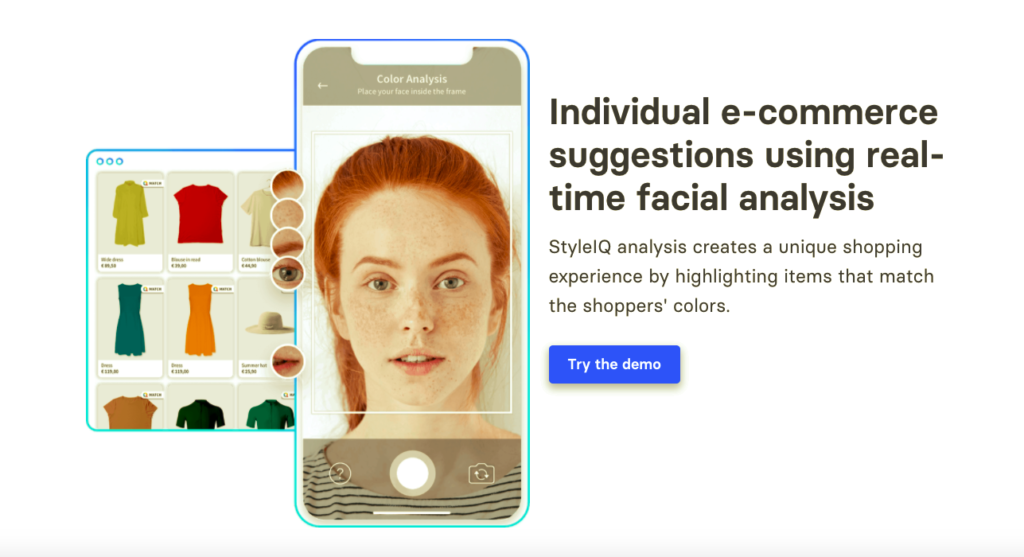- 10 Best AI-powered Practices for eCommerce
- 1. Revolutionizing Conversations With Customers
- 2. Improved Search Capabilities
- 3. Personalized Product Recommendations
- 4. Better Logistics and Price Optimization
- 5. High-converting and Error-free Content Creation
- 6. Next Level Online Shopping Reality
- 7. Easier Checkout
- 8. Data Protection
- 9. Analyzing Marketing Campaign Performance
- 10. Handling Reviews
- Wrapping Up
AI Boom in eCommerce: 10+ Ways Artificial Intelligence Helps Boost Your Business
November 8, 2021 7 min. read

Contents:
Try AI-Driven Insights
Monitoring for Free
Discover new business ideas and growth opportunities using
our AI-powered insights monitoring tool
There is much speculation that artificial intelligence is set to evolve drastically in the next few years. But if you look around, you will realize that it is already a central part of our lives. And indeed, it’s just about everywhere—from self-checkout registers to virtual assistants in mobile phones.
But AI (for the eCommerce sector specifically) has become increasingly in demand since the start of the COVID-19 pandemic. And no surprise, the pandemic intensified the popularity of online shopping, often because it was the only option for customers experiencing lockdown restrictions.
But even now with the tension slowly releasing, a seamless online shopping experience has become embedded in our lives as a habit and a must-have. And the numbers agree: AI in retail is expected to grow by almost 35% by the end of 2027.
This article will share powerful AI-based practices and tools that eCommerce businesses can use to provide a smooth online product shopping and service user experience, increasing sales and customer retention rates. Stay tuned!
10 Best AI-powered Practices for eCommerce
As an eCommerce business owner, you may well know that, unfortunately, not every website visitor turns into a customer. Some reasons why you are not getting more paying customers might be targeting the wrong audience, ineffective call-to-actions (CTAs), and poor user experience. Thankfully, AI can help you learn more about your prospects, design better marketing campaigns, improve usability, provide quicker responses, and much more.
1. Revolutionizing Conversations With Customers
Chances are, most of your customers might be leaving without a purchase because they didn’t get enough attention, or simply had a difficult time finding what they wanted. To avoid this, many businesses turn to AI tools that guarantee a smoother customer experience.
Voice Assistants
Today’s users are getting more used to communicating with devices via voice assistants like Alexa or Siri instead of pressing buttons and typing text. And no wonder—it’s fast, hands-free, and hassle-free! So just imagine how voice search and virtual assistants can improve customer search quality while shopping or looking for services online. So this is definitely an AI tool to keep an eye on.
Conversational Chatbots
While virtual voice assistants are just starting to evolve, chatbots have already been around for some time. These real-time human-like conversations have proved to be quite powerful tools that benefit eCommerce businesses in many ways:
• collecting and qualifying leads no matter what time zone you and your customers are in;
• automating responses and collecting feedback 24/7;
• scheduling sales calls and meetings;
• recommending products and services;
• and much more!
If you are still wondering whether you need a chatbot or not, check out how eCommerce giants such as Starbucks and Sephora are boosting conversations with their customers via chatbots.

Image source: www.sephora.com
2. Improved Search Capabilities
Chatbots and voice assistants will also easily cope with this task and help visitors find what they are looking for. But there’s another game-changer—visual search.
Visual Search
We bet that at one point you’ve probably wanted to buy something but had no clue how to search for it. Almost everyone will agree that happens a lot with clothing—you come across a picture online and want to find it somewhere so badly!
Here’s where AI technology, with its ability to convert images into interpretable information, comes in handy. It can help customers find exactly what they don’t know the name of in a matter of clicks, just using a visual search.
Amazon and Chinese Taobao use this feature to help millions of customers identify products via their camera phone or uploaded images. This radically increased their sales! Another example of image recognition technology is Pinterest, which enables users to select an item in any picture and then ask Pinterest to browse for similar items.

Image source: https://pinterest.com/
3. Personalized Product Recommendations
We all know that today’s users expect a pretty high level of personalization. Using AI, brands can more efficiently scan customer purchase history, predict their behavior, and recommend products and services that they are more likely interested in and thus more likely to buy.
Based on Purchase History
Take Netflix, for instance, which makes movie and TV series recommendations based on users’ watch history. That saves heaps of time searching and frees time for watching!
Amazon is another example of a company helping their customers discover products they might want to buy based on customers’ browsing history or similar purchases on their website, through emails or targeted advertising.

Image source: https://www.amazon.com
As a result, with little data required to make those recommendations and AI’s self-learning and improvement abilities, the performance might become a significant source of revenue for an eCommerce business.
Virtual Shop Assistants
We’ve already mentioned the voice assistants you are all familiar with, such as Siri, Google Now, and Alexa. Perhaps the most interesting on the list (for eCommerce businesses) is Alexa.
By using it on Amazon’s Echo device, customers can discover best-selling products or the best deals on Amazon, create shopping lists, and shop for groceries via Amazon’s partner websites like Fresh or Whole Foods Market. As you can see, the days you need to rush to the nearest store for fresh bread will soon be long gone.

Image source: https://www.amazon.com/
Another great example of evolving virtual personal shoppers is Mona. Need a new pair of shoes or your favorite jersey? Simply ask Mona! She will search 300+ retailers to find your favorite product for the best price.
There are now even AI-powered solutions for fashion eCommerce businesses like StyleIQ that will analyze users’ photos to highlight items that best match their looks.

Image source: https://styleriser.com
4. Better Logistics and Price Optimization
By forecasting transit times, demand levels, and shipments delays, AI can revolutionize the logistics and supply chain processes. It does so with the help of RFID tags, sensors, inventory management, and real-time customer data.
For example, recent research proves that real-time customer analytics has become crucial as it helps predict not only the demand but also optimizes prices. These two, in fact, always go together as AI-enabled dynamic pricing is a strategy always based on supply and demand. That’s why with access to this data, eCommerce businesses can sell more products for the best price!
Just think of what recently happened with products that suddenly experienced high demand due to the COVID-19 epidemic, such as masks and hand sanitizers. Imagine how much easier it would have been if these predictions would have been made by AI.
5. High-converting and Error-free Content Creation
When it comes to communications with customers, content is king—users make purchase decisions if your content speaks to them. Let’s break down how AI-based tools can help you with this.
Product Descriptions
Customers use product descriptions to make purchase decisions. That’s why it’s crucial they pique the interest of potential buyers. With the help of AI, you can easily create messages that address the right segments and keep your messages on brand.
Ads Content Generation
AI-powered tools can automatically create copies based on the audience’s interests, test them, and pick those with higher conversion rates.
AI-generated content might still need some fine-tuning from you, but it will definitely save heaps of time brainstorming and testing your social media posts and Facebook ads.
Auto-generated Images
Generative AI saves a great deal of time on photo shooting, selecting, editing, or processing images. The good news is that there are a few AI-based services that can generate and edit images for commercial purposes or analyze your entire product catalog.

Image source: https://vue.ai/
6. Next Level Online Shopping Reality
The use of virtual reality (VR) and augmented reality (AR) might become the new reality of online shopping.
VR Tools
Consider having a full-on shopping experience—cruising around the store, picking items you like, and trying them on—with only one difference: you’re not leaving your home and literally doing everything from your coach!
AR Tools
AR is already becoming an evolving eCommerce tool. With this technology, customers can virtually try on accessories and apparel and switch between different color options.

Image source: https://www.eyebuydirect.com/
7. Easier Checkout
An easier checkout has indeed become the inevitable part of a seamless customer experience. Studies show that 26% of online shoppers abandon their orders simply because the checkout process is too complicated and takes forever.
Wearable Technology
Take Amazon, for example. Amazon Go creates the smoothest and, most importantly, cashless online shopping experience with little information required from customers and no checkout process. You do the shopping, they deliver the goods and charge you from your Amazon account.
8. Data Protection
People’s most common concern about online shopping is a higher chance of fraud compared to offline shopping. Many users still avoid shopping online because they are not ready to share sensitive data, like their credit card details. The eCommerce businesses were more vulnerable to fraud back in the day, but now, thanks to AI technologies, it has become easier to detect anomalies in bank card usage based on past buying behavior or the newest recognition technologies.
Face and Voice Recognition
Such technologies as Captcha or ReCaptcha help prove the customer is a human, not a robot, thus increasing security standards. But this is not the only option. Users give more credence to facial recognition technology. After all, it’s more reliable because it is much more difficult to defraud.
On top of better privacy, along with face or voice recognition technology, customers get a nearly flawless shopping experience.
9. Analyzing Marketing Campaign Performance
One of the most incredible things about using AI-powered tools is that they always provide you with analytics to know how effective your campaign performance is. And perhaps most importantly, adjust it if necessary.
10. Handling Reviews
More often than not, customers make a buying decision based on the reviews. And they are crucially important for eCommerce businesses because customers can’t physically see or touch the products. But what if the bad reviews are fake?
We bet that almost every online retailer has a sad story about a fake product review created by a competitor or other third-party pushing users to refrain from buying their products. To avoid this practice, eCommerce retailers like Amazon (of course!) now use AI to detect and tackle those fake reviews.
And more than that, AI also helps them rank reviews that are marked as most helpful by other users or the most up-to-date ones and show them first on the list.
Wrapping Up
AI technology is changing the eCommerce industry and, fortunately for customers, improving their online shopping experience. As we’ve shown you in this article, it is becoming evident that AI-powered eCommerce platforms will take over those who are not ready to adopt the latest technologies. So why wait? There are loads of tools that suit small businesses and even more for bigger online retail companies to choose from.
More useful content on our social media:
